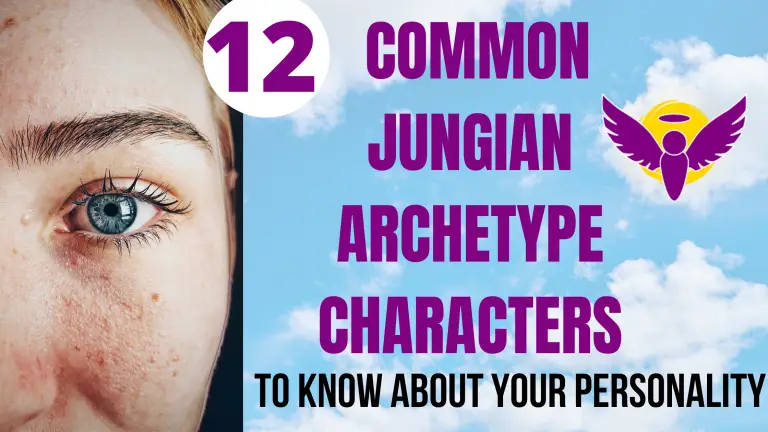Table of Contents
What is a Character Archetype?
An archetype is a fictional character who symbolises a specific set of universally recognisable characteristics and actions.
Carl Jung, considered to be one of the founding fathers of psychoanalysis, proposed that they are a component of the human collective unconscious, which includes all people. In his opinion, these recurrent figures are an integral element of the mythmaking fabric that is shared by all humans.
Because the characters in our stories represent the spirit of our stories, they must have depth and be fully realised. Today we will examine a topic in psychology that may help you: the 12 archetypes identified by Carl Jung.
In Carl Gustav Jung’s theory of the human psyche, the concept of the archetype is widely used. These mythological characters, which he feels are lodged in the collective unconscious, are considered to be present in all human cultures and are applicable across the board.
Jung identified twelve primary kinds that capture fundamental human motives. There are certain values, meanings, and personality traits associated with each kind. There are three additional subcategories to the twelve forms of relationships: the Ego, the Soul, and the Self.
In general, most people have many archetypal personalities, though the archetype tends to predominate. The types of archetypes that are at risk give us an opportunity to examine a person’s motives and behavior.
What are the 12 archetypes?
The Ego Types
- The Innocent
- The Caregiver
- The Hero
- The Orphan
Soul Types
- The Explorer
- The Rebel
- The Lover
- The Creator
Self type
- The Joker
- The Mentor
- The Magician
- The Ruler
Jungian archetypes list
The Innocent:
To put it simply, the innocent are ignorant and inexperienced. However, they were really pleased. When you want to be liked and be noticed, there will be moments when it will be for good and there will be others where it will be negative. As a result, he does things perfectly in order to avoid getting reprimanded. His greatest flaw is his penchant for being dull, while his greatest strength is his confidence in a positive outcome. Other terms for the innocent include utopians, naive, mystical, holy, romantics, and dreamers.
The Caregiver:
A caregiver holds the belief that the way others wish to be treated should be respected. It is protective and nurturing. He is most concerned about being selfish and ungrateful. His strategy is to protect and serve others, and hence, he is vulnerable to losing his identity as a martyr and being used. His greatest talent is his capacity for compassion and charity. Also known as a saint, altruist, parent, and helper, the caregiver is frequently called a saint, altruist, parent, and helper.
The Hero:
In order to meet our requirements, the Ego attempts to fulfil us, while the hero or warrior takes care of the needs being fulfilled. In order to be accepted by society, the hero undertakes heroic acts. This guy is competent and brave, yet overconfident and impulsive. As long as he is fighting, the hero welcomes him into his arms. He is afraid because he believes he is vulnerable and weak. To help him realise his goals, and counteract his weaknesses, he wants to be as powerful and capable as possible. This character is known by various monikers, including the hero, the warrior, the rescuer, the superhero, the soldier, and the winner.
The Orphan:
It is our sense of belongingness that instructs us as to which qualities we should keep hidden in order to blend in with others, and which to reveal to others in order to draw attention to ourselves. Most of all, he aims to blend in and be inconspicuous. Avoid potential compromise or hazardous circumstances. He values safety beyond all else. He is pragmatic and down-to-earth, with an easy-going personality and an affinity for practicality. Other nicknames for him include a realist and a good son.
The Explorer:
In the words of the Explorer, the Explorer wants freedom and the wind on their wings, and hates being confined. People don’t like being bored, and they’re constantly on the move in pursuit of the next great adventure. An adventurer is well-deserving of her reputation as a fearless explorer. His greatest desire is to discover who he is through travelling around the world. Your greatest fear is being stuck, conforming to the masses, and feeling as if you are completely empty inside. His Achilles’ heel is wandering aimlessly, and he will even turn into a misfit. They are independent, and ready to make their own mark. In addition to being a traveller, the explorer is also referred to as a wanderer, a pilgrim, an individualist, and a seeker.
The Rebel:
The Rebel says that rules were established to be defied. It’s all about revolution, revenge, and the desire to destroy things that are worthless. He is a fanatical, radical, and occasionally deluded individual. It annihilates everything that does not meet its requirements or is unable to comprehend in order to defend itself from possible dangers. His gifts are flamboyance and wide-ranging creative flexibility. While he is often remembered as a revolutionary, he is also known as a destroyer and as a wild guy.
The Lover:
The lover is motivated by the need to find their other half, or something to replace what they lack. In their own unique manner, yet with all their hearts, they love. The best way to tap into the needs of your consumers and your environment is to focus on pleasing both groups. He’s committed to doing good deeds because of his virtues of enthusiasm, thankfulness, appreciation, and commitment. The problem is that this desire is focused outside of one’s own identity in order to please others, which has the possibility of losing one’s own self. In addition to these various names, lovers are also referred to as lovers, passionate, sensual, or spouses.
The Creator:
The artist craves immortality after death, and the only form of immortality he knows of is to be remembered as an artist. They want to leave a legacy, so that they will have a chance to live on when they are gone. They can suffer when it comes to their artistic endeavours, since they are too meticulous about getting everything just right. That causes him to be dissatisfied, since he’s spreading himself too thin. They believe that if you can think of something, then you can achieve it. Their aim is to do valuable work, and hence, they fear becoming mediocre. They have a wealth of imagination and creativity. They are also referred to as a creator if they are an artist, innovator, dreamer, or musician.
The Joker:
Everything is hilarious to the insane, resulting in a looseness in everything.He lives by a simple motto: “You only live once.” They aim to savour each moment by indulging in what they like. They are truly joyful. His entire life revolves around jokes, playing games, and making people laugh. Your greatest worry is being uncreative and being uninteresting to others. He has a proclivity for impulsive and thoughtless use of time.A madman, also known as an idiot, a joker, a comic, or a joker, is a person who is insane.
The Mentor:
Honesty is always a matter of cost to the wise. They seek to comprehend everything around them, people, and how things work. While they are observant and analytical, they can also be so meditative that they do not take action. “The truth will set you free” is one of his core beliefs. They apply their intellectual prowess and critical thinking to better understand the world. The fear is that they will be lied to and will remain ignorant. Although recognised as a philosopher, researcher, planner, and thinker, he is also referred to as an intellectual.
The Magician:
In contrast to being smart people, magicians are less analytically minded. They strive to comprehend the mysteries of the universe, to comprehend the mysterious corners of the world, and to overcome those mysteries and apply their findings to benefit others. They aim to bring people’s aspirations to fruition based solely on hope. Actions have consequences, and since they have a significant impact on everything they do, the bad side effects of their actions could become problems for them. His talent is his lifelong quest for helpful and positive outcomes for everyone. Because they can be manipulative, they are at risk of losing their integrity. Many people also refer to magicians as visionaries, catalysts, inventors, leaders, or healers.
The Ruler:
Control and power are both important, but only power is the essential thing. They desire to be successful in what they do, whether they are doing something creative or practical. If they fail, they will not accept it. It is tied to the concepts of order and rule-basedness. More important than everything else, they seek control, prosperity, and power. As a result, their fear is also panic and their regime overturned. They have difficulty delegating authority. He possesses above-average talent in the areas of responsibility and leadership. There are other terms for it, including boss, leader, king, and administrator.

Jungian archetypes test
Learn Jungian Archetype test at Individualogist
The Origins: Why did Carl Jung come up with archetypes?
Jung felt that the collective unconscious, often known as the collective psyche, was where the archetypes exist. These models are innate, universal, and genetic, according to him. For the most part, archetypes are unlearned and work to structure how we see certain experiences.
Many feel that an archetype is tied to an individual’s personality, although Jung himself believed that the majority of people were influenced by one archetype in particular. Regardless of an individual’s cultural influences and an individual’s own individual personal experiences, archetypes are shown or fulfilled in an actual fashion.
Also, Jung postulated that there were four major archetypes, but he believed that there were no limits to the number of archetypes that could exist. To infer their existence, we go to religion, dreams, art, and literature.
What are Carl Jung’s 4 theories of consciousness?
According to Jung, there are four basic archetypes that he describes, in addition to several others that are commonly associated with them:
The Persona
Our public image is represented by our persona. “Persona” is derived from the Latin term “mask,” which is used to describe someone’s public image. It is not a true mask, although it does look similar to one.
It’s an in-depth representation of our numerous social masks. To protect the ego from feelings of shame, it intervenes. Identities may manifest in dreams and take numerous forms, according to Jung.
The Shadow
An archetype is an image created by a combination of fundamental human drives, such as sex and life. Though unconscious, a person’s shadow consists of the collective unconscious’s beliefs, weaknesses, desires, impulses, and shortcomings that have been repressed.
When people try to conform to the standards of their surrounding culture, a shadow is formed. What we’re looking at here is the archetype of the unacceptable, which includes all of the things society (and one’s own personal morals and beliefs) reject. This could be about things such as jealousy, greed, prejudice, hatred, and anger.
The Anima or Animus
In males, the anima is a feminine representation, whereas in females, the animus is a masculine representation. It is our anima/animus, which is sometimes referred to as the “real self,” that connects us to the collective unconscious.
Jung thought that both physiological and social factors had an influence on gender identity and sex roles. It appears that the animus and anima archetypes may have been involved in this process, according to Jung. According to Jung, the animus is considered to be a masculine personality trait in women, whereas the anima is thought to be a feminine personality trait in men.
The Self
The self is an archetype that is both an expression of our own unconscious and the conscious awareness of it. Depending on the Jungian perspective, the self can be represented as a circle, a square, or a mandala.
Individuation is the process in which the various components of personality are combined to form the self. Jung was of the opinion that conflict between the unconscious and the conscious mind could result in psychological difficulties. Discovering and reconciling tensions during the individuation process was key.











